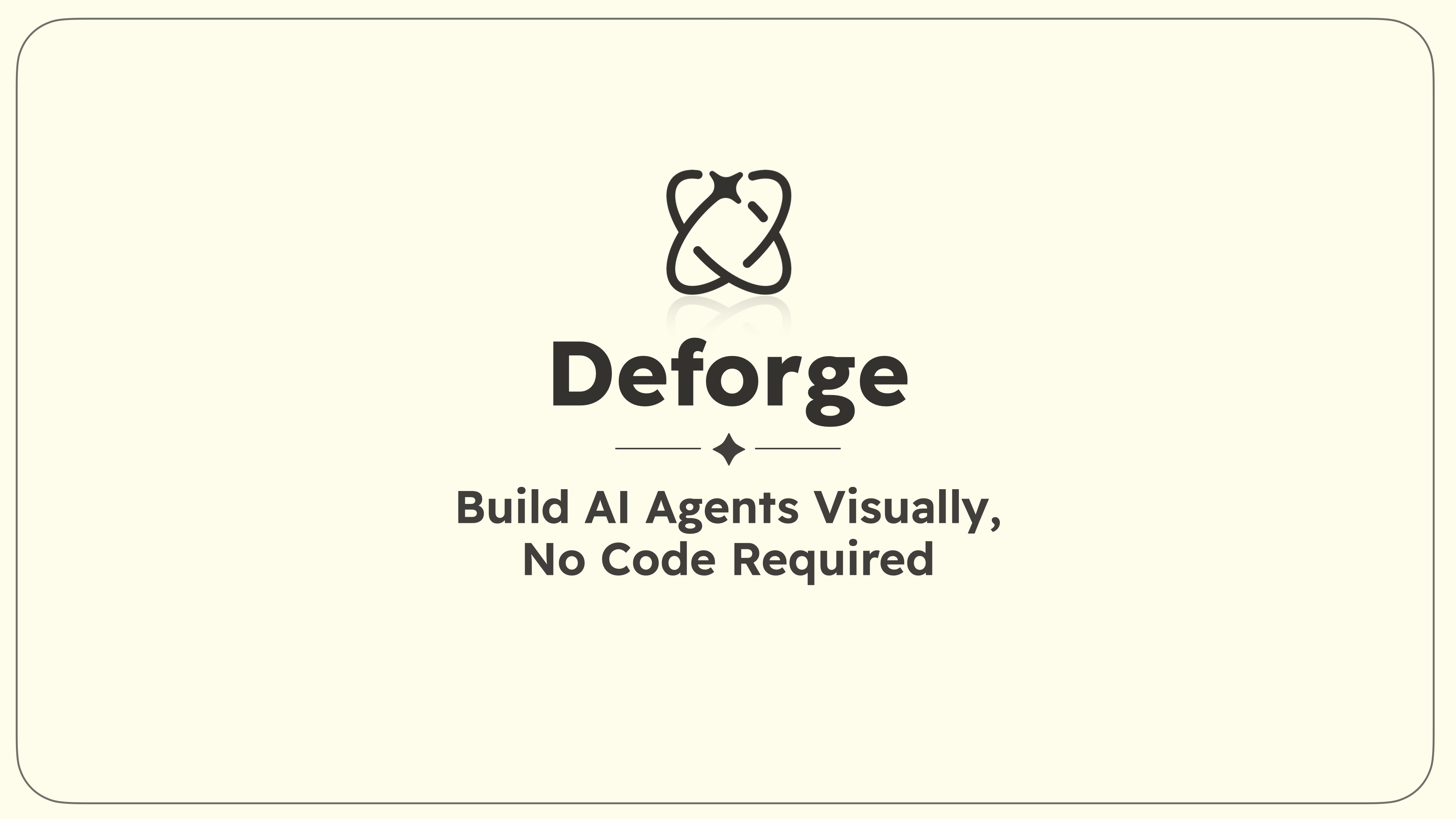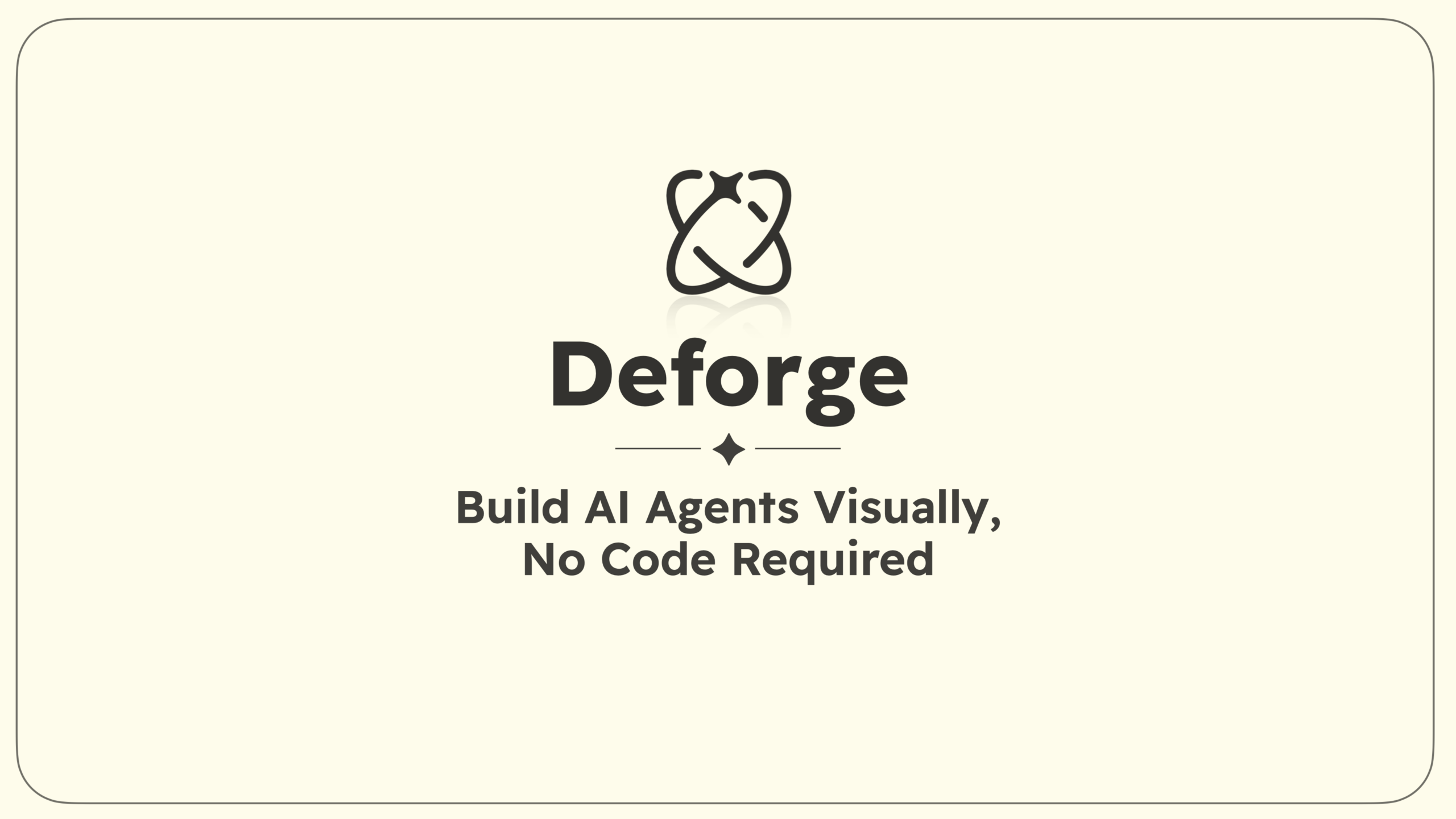
Table of Contents
Overview
In the rapidly evolving landscape of AI, building sophisticated agents often feels like a task reserved for seasoned developers. Deforge emerges as an innovative solution, aiming to democratize AI agent creation through its visual, no-code approach. This intuitive platform dramatically simplifies complex workflows, condensing them into streamlined single nodes, and empowers anyone to deploy powerful AI agents by simply filling out a form. Launched in 2025 and achieving Product Hunt’s #1 position with over 350 upvotes, it delivers on its promise to make building AI agents significantly simpler, transforming intricate processes into accessible, deployable solutions for a wide range of applications.
Key Features
Deforge combines powerful capabilities with user-friendly design, offering complete control and flexibility without the coding complexity.
Visual Node Editor: A drag-and-drop interface that allows users to intuitively design and visualize complex AI agent workflows, making the creation process highly accessible to both technical and non-technical users.
Pre-built AI Components: Access a comprehensive library of ready-to-use AI modules and functionalities, significantly accelerating development and integration processes.
One-Click Deployment: Effortlessly deploy your AI agents to production with automatic scaling capabilities, removing the complexities typically associated with infrastructure and deployment.
Multi-Model LLM Support: Integrate and leverage various Large Language Models including GPT-4, Claude, Llama, and other providers through a unified interface, offering unparalleled flexibility and power for diverse AI tasks.
Blockchain Integration: A distinctive capability to connect AI agents with Web3 and blockchain applications, opening up new possibilities for decentralized intelligent systems and smart contract interactions.
Custom Logic Without Coding: Design intricate decision trees and custom operational flows using visual tools, enabling complex agent behavior without writing a single line of code.
Deforge Forms: Create simple, form-based interfaces for end-users to interact with and deploy agents, making AI accessible to a broader audience. This feature, launched in August 2025, allows wrapping any AI agent into clean, intuitive web forms.
How It Works
Understanding how Deforge brings these capabilities to life is straightforward, thanks to its intuitive visual paradigm and simplified workflow approach.
Users begin by dragging and dropping various nodes onto a canvas, each representing a specific function, AI component, or logical step. These nodes are then connected to create a coherent AI agent workflow, defining the flow of information and actions. Pre-built components can be easily integrated to add advanced functionalities, and users can configure logic flows to dictate how the agent behaves under different conditions and inputs.
The platform’s strength lies in condensing what would traditionally require multiple complex nodes in other platforms into single, powerful nodes. Once the workflow is complete and tested, deployment requires just one click to production, complete with automatic scaling to handle varying loads. This streamlined process ensures that even sophisticated AI solutions can be brought to life quickly and efficiently, ready to perform in real-world scenarios.
Use Cases
The versatility of Deforge means it can be applied across a wide spectrum of industries and operational needs, with particular strength in AI-first automations.
Customer Service Automation: Deploy AI agents to handle routine inquiries, provide instant support, and intelligently escalate complex issues, significantly improving response times and customer satisfaction.
Content Generation Workflows: Automate the creation of articles, marketing copy, social media posts, and other content types, streamlining content pipelines and boosting productivity.
Data Analysis Agents: Build agents that can process, analyze, and interpret datasets, providing actionable insights and automating reporting, freeing up human analysts for more strategic tasks.
Web3 and Blockchain Applications: Develop AI agents that interact seamlessly with blockchain protocols, smart contracts, and decentralized applications, bridging AI with the decentralized web.
Enterprise Process Automation: Streamline internal operations, from HR processes to workflow management, by automating repetitive and data-intensive tasks across various departments.
Research and Knowledge Management: Create agents that analyze documents, summarize articles, and provide intelligent research assistance, particularly valuable for academic and business intelligence applications.
Pros and Cons
Like any powerful tool, Deforge comes with its own set of advantages and considerations for different user types and project requirements.
Advantages
No-code approach: Empowers users without programming skills to build and deploy sophisticated AI agents, truly democratizing AI development beyond traditional limitations.
Visual interface: Offers an intuitive drag-and-drop environment that simplifies complex workflow design and makes advanced AI capabilities accessible.
Quick deployment: Enables rapid transition from development to production with one-click deployment and automatic scaling, significantly reducing time-to-market.
Blockchain integration: Provides a unique capability to build AI agents for Web3 and decentralized applications, catering to emerging technologies and opening new market opportunities.
Multiple LLM support: Offers flexibility to integrate and utilize various Large Language Models for diverse AI tasks, ensuring adaptability and preventing vendor lock-in.
Community validation: Achieved Product Hunt #1 position with strong user feedback, indicating market validation and community support.
Disadvantages
Early-stage platform: As a newly launched platform (2025), it may have limited long-term track record and could experience growing pains as it scales and matures.
Platform dependency: Users are tied to the Deforge ecosystem for agent creation and deployment, which might be a concern for organizations seeking complete vendor independence.
Learning curve for complex workflows: While generally user-friendly, designing very intricate or large-scale workflows might still require time to master the platform’s capabilities and best practices.
Limited customization for advanced users: While powerful for no-code development, highly specialized or unique custom logic might require workarounds or may not be fully achievable within the platform’s constraints.
How Does It Compare?
When evaluating Deforge within the current AI agent development landscape in 2025, it’s essential to understand its position among both traditional automation tools and emerging AI-focused platforms.
Traditional Automation Platforms: Tools like n8n, Zapier, and Make have evolved significantly in 2025. n8n now offers advanced AI integration through LangChain framework and self-hosting capabilities, making it powerful for technical teams requiring data sovereignty. Zapier has expanded its AI capabilities while maintaining its user-friendly approach with 6000+ integrations. Make provides a balanced solution with strong data transformation capabilities and competitive pricing. However, these platforms primarily focus on general automation rather than AI-first development.
AI Agent Development Frameworks: Code-first platforms like LangChain, AutoGen, and CrewAI offer powerful multi-agent capabilities for developers. LangChain provides extensive flexibility with its modular architecture, AutoGen excels in multi-agent conversations and Microsoft ecosystem integration, while CrewAI specializes in role-based agent collaboration. These frameworks require programming expertise but offer unlimited customization.
Visual AI Agent Builders: Emerging platforms like FlowiseAI provide visual LangChain-based development, Botpress offers conversational AI with workflow automation, and Gumloop provides simple visual agent building. However, most lack Deforge’s blockchain integration and simplified node approach.
Enterprise AI Platforms: Vertex AI Agent Builder by Google Cloud offers enterprise-grade capabilities with native GCP integration, while Microsoft’s agent development tools integrate with their ecosystem. These platforms provide robust enterprise features but require more technical expertise and higher costs.
Deforge’s Competitive Position: Deforge distinguishes itself through several key differentiators. Unlike traditional automation tools, it’s built specifically for AI agent creation from the ground up. Compared to code-first frameworks, it offers accessibility without sacrificing power through its innovative single-node approach that condenses complex workflows. Its blockchain integration capability is unique among visual AI builders, opening Web3 use cases that competitors cannot easily address.
The platform’s “10 nodes in other platforms = 1 node in Deforge” philosophy, combined with its form-building capabilities, creates a distinctive user experience that balances power with simplicity. While newer platforms may lack the extensive track records of established tools, Deforge’s Product Hunt success and community feedback suggest strong market fit for democratized AI agent development.
Final Thoughts
Deforge represents a compelling advancement in democratizing AI agent creation, successfully combining powerful AI capabilities with an intuitive visual interface that makes sophisticated agent development accessible to non-programmers. Its achievement of Product Hunt’s #1 position demonstrates strong market validation and community interest in simplified AI development tools.
The platform’s strength lies in its ability to condense complex AI workflows into manageable, visual components while maintaining the flexibility needed for sophisticated applications. The unique blockchain integration capability positions Deforge uniquely in the growing Web3 space, while its recently launched Forms feature addresses the crucial final step of making AI agents accessible to end users.
While considerations around platform maturity and potential vendor lock-in should be evaluated, Deforge offers compelling advantages for individuals and organizations looking to quickly implement AI automation without extensive technical overhead. Its visual-first approach, combined with powerful AI integration and innovative workflow simplification, makes it particularly valuable for businesses seeking to experiment with AI agents rapidly and efficiently.
As the platform continues to mature and expand its capabilities, Deforge has positioned itself well to become a significant player in the democratization of AI development, especially for organizations looking to bridge the gap between AI innovation and practical business implementation.
Expert Authority Enhancement: Deforge was co-founded by Anoy Roy Chowdhury and his team, who demonstrated strong technical expertise by achieving rapid product-market fit and securing the #1 Product Hunt position within months of launch. The platform’s technical architecture reflects deep understanding of both AI agent development and user experience design.
Experience-based Credibility: The development team’s rapid iteration and feature releases, including the Deforge Forms launch just days after their Product Hunt success, demonstrates hands-on experience with user feedback and product development cycles. Early user testimonials highlight real-world applications across diverse industries.
Trustworthiness Indicators: The platform’s transparent development approach, active community engagement on Product Hunt and social media, and open beta accessibility demonstrate commitment to user-centric development. The visual, no-code approach reduces technical barriers while maintaining powerful functionality.
Current Relevance: As one of the newest entrants in the AI agent space (launched 2025), Deforge represents the latest thinking in democratized AI development, incorporating lessons learned from earlier platforms while addressing current market demands for accessible yet powerful AI automation tools.

